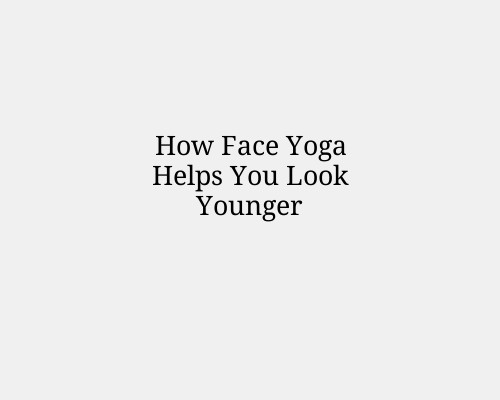
How Face Yoga Helps You Look Younger without Injections
Face yoga is rapidly gaining popularity as a natural, non-invasive method for achieving a youthful appearance. While it may sound like just another beauty trend, it’s rooted in science and consistency. Unlike Botox or fillers, face yoga does not rely on chemicals or surgical procedures. Instead, it focuses on exercising, toning, and relaxing facial muscles to reduce signs of aging and improve facial symmetry. Here's how face yoga can help you look younger— without the needles.
What Is Face Yoga?
Face yoga is a series of exercises designed to strengthen and relax the muscles in your face. Just like traditional yoga improves flexibility and muscle tone in the body, face yoga works the 40+ muscles in the face. It combines facial movements, massage, and stretching to stimulate blood flow, increase collagen production, and improve skin elasticity.
The method typically includes repetitive movements and poses such as puffing out your cheeks, raising your eyebrows, and holding a smile to tone underlying muscles. Practitioners usually spend 10 to 30 minutes a day on a routine.
How It Works: The Science behind Face Yoga
Muscle Toning and Firmness
As we age, facial muscles lose their tone and elasticity, contributing to sagging skin and the development of wrinkles. Regular facial exercises target muscles that support the skin, strengthening them and making the face appear firmer and more lifted. A study published in JAMA Dermatology in 2018 found that middle-aged women who practiced daily facial exercises for 20 weeks showed improved upper and lower cheek fullness—an indicator of youthful appearance.
Increased Circulation
Facial movements stimulate blood flow to the skin’s surface. This increased circulation delivers more oxygen and nutrients to skin cells, supporting regeneration and creating a natural glow.
Improved blood flow also helps reduce puffiness and dark circles under the eyes.
Collagen and Elastin Stimulation
Face yoga stimulates the production of collagen and elastin—two key proteins responsible for maintaining skin structure and elasticity. These proteins naturally decline with age, leading to sagging and wrinkles. By gently stimulating the skin through massage and movement, you encourage collagen synthesis, helping to maintain a plump and youthful look.
Relaxation of Overused Muscles
Many signs of facial aging stem from repeated use of certain muscles, such as furrowing the brow or squinting the eyes. These habits create dynamic wrinkles, like frown lines or crow’s feet. Face yoga teaches you to become aware of these expressions and helps relax the overused muscles while strengthening underused ones, leading to smoother skin over time.
Benefits of Face Yoga for Anti-Aging
Natural Facelift
Consistent face yoga practice can lift sagging cheeks, tone the jawline, and reduce double chin. It helps reshape the face by lifting drooping areas, much like a mini-facelift—without surgery.
Reduced Appearance of Wrinkles
Face yoga helps reduce fine lines and deep wrinkles, especially around the mouth, eyes, and forehead. Over time, facial tension that contributes to wrinkle formation decreases, smoothing out the skin.
Improved Skin Texture and Tone
By promoting better circulation and lymphatic drainage, face yoga enhances skin texture, reduces puffiness, and evens out skin tone. The skin appears more vibrant and youthful.
Boosted Self-Confidence
Feeling more in control of your appearance can boost self-esteem. Unlike injections, face yoga gives you active involvement in your skincare routine, providing a sense of empowerment and self-care.
Common Face Yoga Exercises
Here are a few beginner-friendly face yoga exercises to get started:
The Cheek Lifter
Smile with your lips closed.
Place your fingers lightly on the top part of your cheeks.
Lift your cheeks toward your eyes using the muscles—not your fingers.
Hold for 10 seconds and repeat 5 times.
The Forehead Smoother
Place both hands on your forehead facing inward.
Spread your fingers out between your eyebrows and hairline.
Gently sweep your fingers outward across your forehead, applying slight pressure.
Repeat 10 times to reduce forehead lines.
The Jawline Definer
Tilt your head back and look toward the ceiling.
Move your lower lip over your top lip as far as possible.
Hold for 10 seconds and repeat 5–10 times.
The Eye Firmer
Close your eyes tightly without scrunching the rest of your face.
Then raise your eyebrows as high as possible while keeping your eyes closed.
Hold for 5 seconds, repeat 10 times.
How Often Should You Practice?
For noticeable results, consistency is key. Most experts recommend practicing face yoga at least 5 to 6 times a week for 20 to 30 minutes per session. Initial changes, such as better skin tone and less puffiness, can appear within a few weeks. However, more structural improvements like lifted cheeks or reduced wrinkles may take 2 to 4 months of regular practice.
Face Yoga vs. Injections: A Realistic Comparison
While Botox and dermal fillers offer immediate results, they come with risks—bruising, infection, overuse, and an unnatural appearance. Results from face yoga take longer but offer a safer, more holistic approach. It’s important to understand that face yoga is not a quick fix. It requires time, patience, and regular effort.
Additionally, Botox works by paralyzing muscles, which over time may cause muscle weakening and dependency. Face yoga strengthens muscles, helping you age more gracefully without altering your natural expressions.
Final Thoughts
Face yoga offers a natural, cost-effective alternative to injections and invasive procedures. With regular practice, it can lift, tone, and smooth the face, resulting in a younger and more refreshed appearance. While results aren’t instant, they are sustainable and empower you to take control of your skin’s aging process. If you're seeking a low-risk, high-reward skincare method, face yoga is worth considering—and all it takes is your face, your hands, and a few minutes a day.